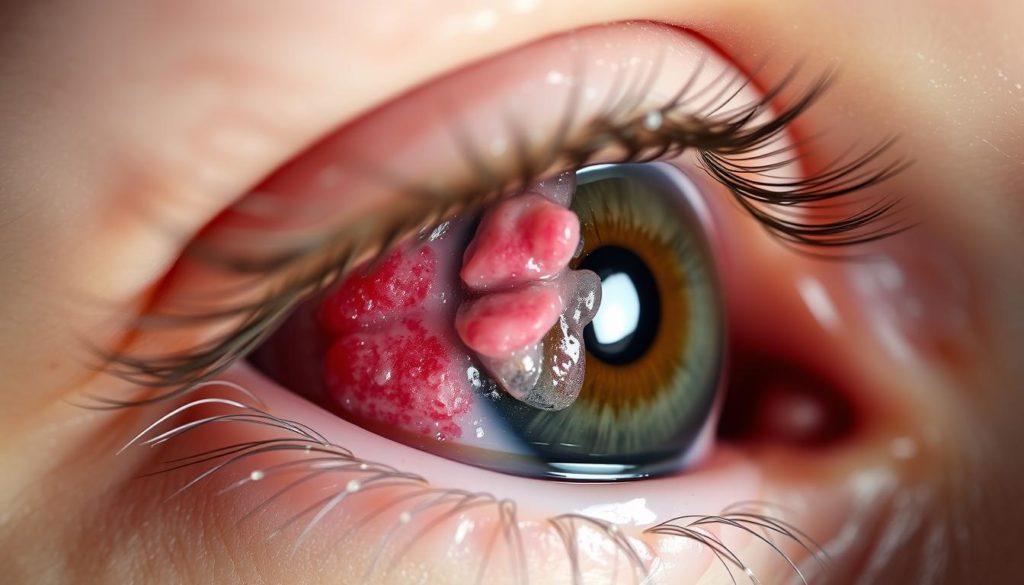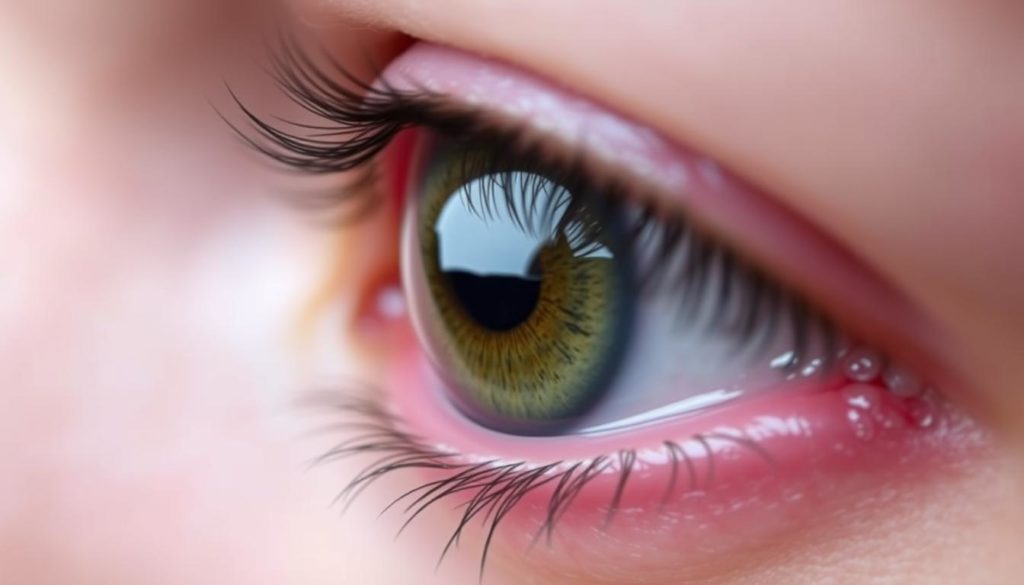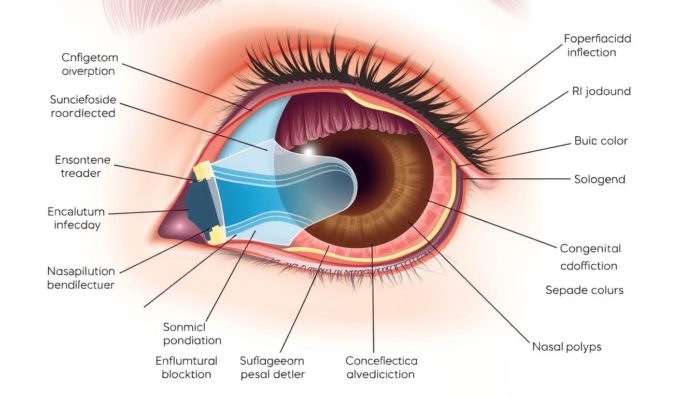Did you know that nearly 30% of infants have blocked tear ducts? This condition can also affect adults. It causes discomfort and eye problems if not treated.
Knowing about eye health is key to understanding blocked tear ducts. Many things can block tear drainage, affecting your eyes. We’ll look at the causes, backed by medical experts, to help you understand this common issue.
What is a Blocked Tear Duct?
A blocked tear duct happens when the path for tears from the eye to the nose gets blocked. Knowing about tear duct anatomy helps us understand how this affects our eyes. The tear duct system includes parts like the puncta, canaliculi, lacrimal sac, and nasolacrimal duct. Tears from the lacrimal glands flow over the eye and drain through the tear ducts.
The nasolacrimal duct is a key part of this system. It connects the lacrimal sac to the nasal cavity. If this duct gets blocked, known as nasolacrimal duct obstruction, tears can’t drain right. This can cause watery eyes and eye infections.

Signs of a blocked tear duct include watery eyes, eye infections, and swelling at the eye corner. You might also see thick, sticky discharge.
Knowing why and how blockages happen helps us find ways to treat and prevent them. Blockages can be due to birth defects, infections, injuries, or aging. Seeing an ophthalmologist can help find the cause and the best treatment.
Learning about tear duct anatomy and nasolacrimal duct obstruction helps us spot symptoms early. This way, we can get medical help quickly.
Common Symptoms of Blocked Tear Ducts
Blocked tear ducts can cause many eye health symptoms. These signs mean you might need to see a doctor. Knowing the signs of nasolacrimal duct blockage helps you get the right treatment.
Excessive Tearing
One key blocked tear ducts symptom is too much tearing. Tears can’t drain well, so they spill over onto your cheeks. You might keep wiping your eyes, especially in windy weather or when you’re upset.

Recurring Eye Infections
Eye infections that keep coming back are another sign of a nasolacrimal duct blockage. Stuck tears can harbor bacteria. Look out for redness, swelling, and discharge. Treating these infections quickly is crucial to avoid bigger problems.
Swelling Near the Corner of the Eye
Swelling near the eye’s inner corner is a common sign of blocked tear ducts. It might also hurt when you press on it. Don’t ignore these eye health symptoms as they could point to serious issues.
Causes of Blocked Tear Ducts
Blocked tear ducts can come from many sources. Knowing what causes them helps in finding the right treatment. This section breaks down the main reasons into four main areas.
Congenital Blocked Tear Ducts
Newborns often have blocked tear ducts. This happens when the tear duct system doesn’t fully form in the womb. Sometimes, it clears up as the baby grows. But, other times, a doctor’s help is needed.
Injury or Trauma
An eye injury or trauma can block tear ducts. Accidents, surgeries, or physical impacts can damage the tear ducts. Quick care and treatment are key to avoiding long-term problems.
Infections
Ocular infections, like conjunctivitis or severe sinus infections, can block tear ducts. These infections cause swelling and block the tear passage. It’s important to treat these infections quickly to prevent more issues.
Age-Related Changes
As we age, our bodies change, including our tear ducts. Age can narrow the tear ducts, making them more likely to get blocked. Regular eye exams can help manage these changes.
Diagnosis of Blocked Tear Ducts
Understanding how doctors diagnose blocked tear ducts is key to treating them. This part explains what happens during the first check-up and how medical images help assess the lacrimal system.
Initial Examination
At the start, a doctor looks for signs of blocked tear ducts during an eye examination. They check the patient’s medical history and examine the eyes closely. This helps figure out how bad the blockage is and where it is.
Medical Imaging
Medical images play a big role in finding out if tear ducts are blocked. Doctors might use dacryocystography or dacryoscintigraphy. These methods give clear pictures of the tear drainage system, helping with a detailed lacrimal system assessment.
| Examination Type | Description |
|---|---|
| Physical Eye Examination | Initial assessment to check for inflammation, redness, and other symptoms. |
| Dacryocystography | Special X-ray technique used to visualize the lacrimal ducts. |
| Dacryoscintigraphy | Nuclear medicine technique to assess tear drainage function. |
Treatment for Blocked Tear Ducts
It’s important to treat a blocked tear duct to keep your eyes healthy. There are many ways to fix this, from simple steps to surgery. Knowing about treatment for blocked tear ducts helps manage the problem well.
The right eye health treatments depend on why and how blocked the duct is:
- Conservative Treatments: These are the first steps. They include warm compresses and massages to open the duct. Antibiotics might be needed if it’s infected.
- Minimally Invasive Procedures: For some, a balloon catheter dilation can help. This is done in a doctor’s office.
- Surgical Options: If other methods don’t work, surgery like Dacryocystorhinostomy (DCR) might be needed. It creates a new path for tears to drain, offering a lasting fix.
Let’s look at how these treatments compare:
| Treatment Method | Effectiveness | Recovery Time |
|---|---|---|
| Warm Compresses and Massage | Moderate | Immediate |
| Antibiotics | High (for infections) | Varies |
| Balloon Catheter Dilation | High | 1-2 Days |
| Dacryocystorhinostomy (DCR) | Very High | 1-2 Weeks |
Blocked Tear Ducts in Infants
Blocked tear ducts are common in newborns. Many cases clear up on their own. But, knowing the symptoms and care tips is key. It’s important to know when to get medical help for newborn tear duct care.
Natural Resolution
Many infants see their tear ducts clear up by the first year. As the tear drainage system matures, blockages often go away. Gentle care and watching for signs of discomfort can help.
Massage Techniques
Massage can help with newborn tear duct care. Gently massaging the area around the tear duct can open it up. Always follow your pediatrician’s advice to avoid harm.
- Wash your hands thoroughly before touching the infant’s face.
- Use a clean finger to gently massage the tear duct area using light pressure.
- Perform the massage several times a day, especially after feedings and before naps.
When to Seek Medical Help
While most cases of infant blocked tear ducts clear up on their own, some need medical help. Look for these signs:
- The eye becomes red and swollen.
- There is persistent discharge that does not improve with cleaning.
- The baby shows signs of discomfort and irritation that do not alleviate.
Getting medical help quickly is crucial. It ensures any pediatric eye conditions are treated right. This helps prevent problems and supports healthy eye growth in infants.
Blocked Tear Ducts in Adults
Blocked tear ducts in adults can cause a lot of discomfort. They can also lead to vision problems. This section will look at non-surgical and surgical treatments for this issue.
Non-Surgical Treatments
Noninvasive eye treatments are often the first step for adults with blocked tear ducts. Some common treatments include:
- Warm Compresses: A warm compress can help open the blockage by softening it.
- Massage: Gently massaging the area can sometimes clear the blockage.
- Antibiotics: Antibiotic drops or pills can treat infections and reduce inflammation.
- Flushing: A saline solution can flush out the tear duct and remove the blockage.
Surgical Options
If noninvasive treatments don’t work, surgery might be needed. A common surgery is dacryocystorhinostomy (DCR). It creates a new path for tears to drain.
| Treatment Type | Description | Success Rate |
|---|---|---|
| Dacryocystorhinostomy (DCR) | Creates a new drainage route for tears from the lacrimal sac directly into the nasal cavity | 90-95% |
| Intubation | Involves inserting a tiny tube into the tear duct to keep it open and allow for proper drainage | 80-85% |
| Balloon Catheter Dilation | A small balloon is inserted and then inflated to open up the tear duct | 75-80% |
It’s important to talk to an ophthalmologist to find the best treatment. The choice depends on the blockage’s severity, the cause, and your health.
Preventing Blocked Tear Ducts
Keeping your eyes healthy is key to your overall well-being. Preventing blocked tear ducts is a big part of eye care. This section will give you tips to keep your tear ducts clear and working right. By following simple advice, you can lower the risk of tear duct blockages and keep your eyes in top shape.
Proper Eye Hygiene
Practicing good eye hygiene is vital to avoid blocked tear ducts. Clean your eyelids and the area around your eyes often to remove dirt or bacteria. Use a soft cleanser and warm water to wash your face every day. Also, avoid touching your eyes with dirty hands to prevent introducing irritants or infections.
Avoiding Eye Trauma
Protecting your eyes from injury is also crucial for tear duct health. Wear protective eyewear during activities that could harm your eyes, like sports or gardening. High-quality safety glasses or goggles can make a big difference in preventing blocked tear ducts. Remember, protecting your eyes is a key part of eye care and keeping them healthy for the long term.
FAQ
What are the main causes of blocked tear ducts?
Blocked tear ducts can happen for many reasons. These include being born with it, injury, infections, and aging. Less often, it can be due to inflammation or tumors.
What are the symptoms of blocked tear ducts?
Symptoms include too much tearing, eye infections that keep coming back, and swelling near the eye corner. You might also see mucus, blurry vision, or eyelash crust.
How is a blocked tear duct diagnosed?
First, an eye doctor will check you. Then, tests like a dye test or dacryocystography might be used. These help find where and how bad the blockage is.
What treatments are available for blocked tear ducts?
Treatments depend on the cause and how bad it is. Options range from warm compresses and massage to more serious methods like balloon dilation or surgery.
Can blocked tear ducts resolve on their own in infants?
Yes, many infant cases clear up on their own by age one. Parents can also try gentle massage to help.
When should you seek medical help for an infant’s blocked tear ducts?
See a doctor if it doesn’t get better by age one or if there’s infection signs like severe swelling or redness.
What non-surgical treatments are available for adults with blocked tear ducts?
Adults can try warm compresses, massage, and antibiotics for infections. Some doctors might suggest balloon dilation.
What surgical options are available for adults?
Adults often have dacryocystorhinostomy (DCR) surgery. It makes a new tear drain. This surgery works well most of the time.
How can you prevent blocked tear ducts?
Keep your eyes clean and avoid eye injuries. Regular eyelid cleaning and avoiding eye risks are important.


